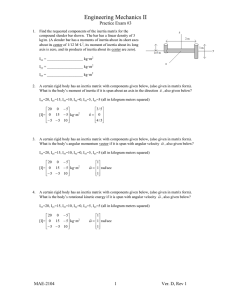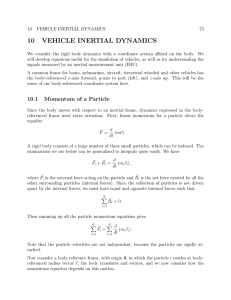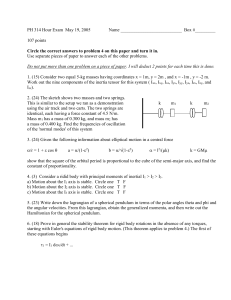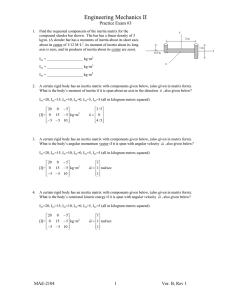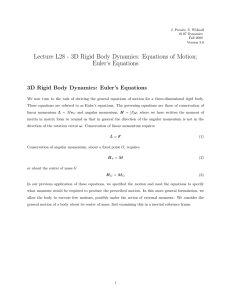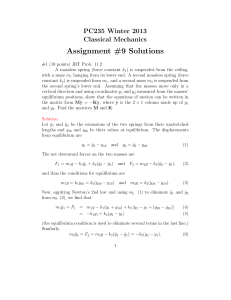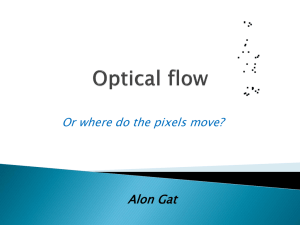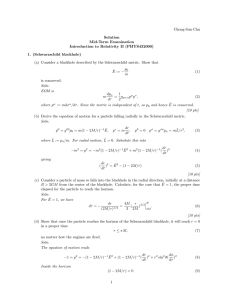Document 13359371
advertisement
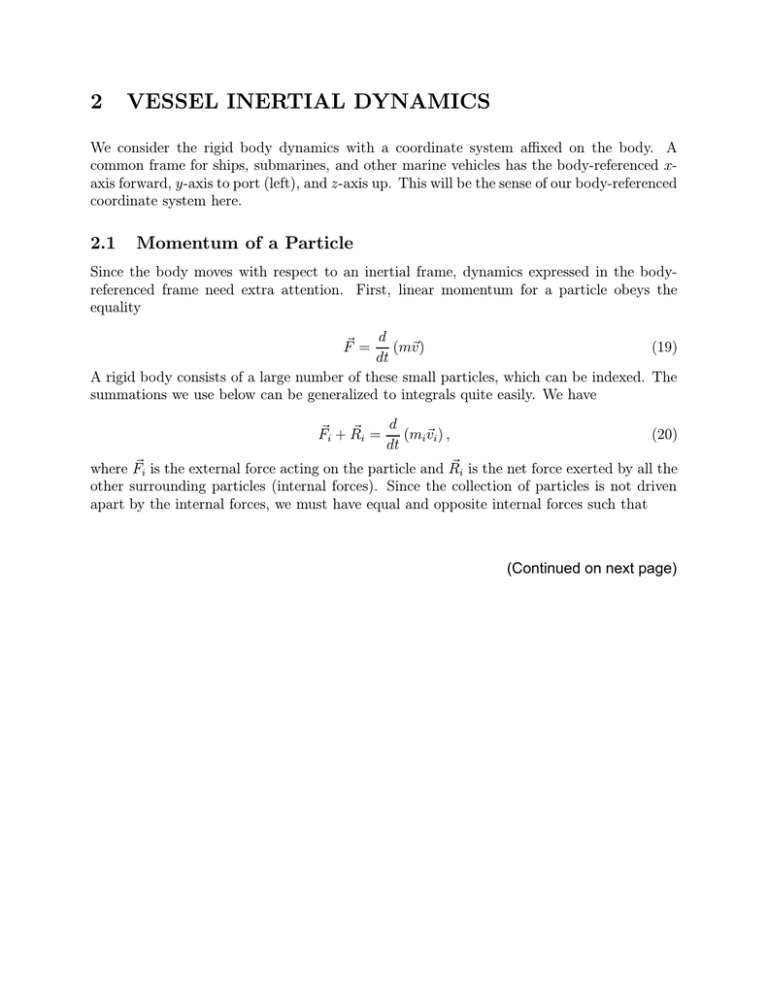
2
VESSEL INERTIAL DYNAMICS
We consider the rigid body dynamics with a coordinate system affixed on the body. A
common frame for ships, submarines, and other marine vehicles has the body-referenced xaxis forward, y-axis to port (left), and z-axis up. This will be the sense of our body-referenced
coordinate system here.
2.1
Momentum of a Particle
Since the body moves with respect to an inertial frame, dynamics expressed in the bodyreferenced frame need extra attention. First, linear momentum for a particle obeys the
equality
d
(19)
Fγ =
(mγv )
dt
A rigid body consists of a large number of these small particles, which can be indexed. The
summations we use below can be generalized to integrals quite easily. We have
γ i = d (miγvi ) ,
Fγi + R
dt
(20)
γ i is the net force exerted by all the
where Fγi is the external force acting on the particle and R
other surrounding particles (internal forces). Since the collection of particles is not driven
apart by the internal forces, we must have equal and opposite internal forces such that
(Continued on next page)
6
2 VESSEL INERTIAL DYNAMICS
N
⎫
γ i = 0.
R
(21)
i=1
Then summing up all the particle momentum equations gives
N
⎫
Fγi =
i=1
N
⎫
d
(miγvi ) .
i=1 dt
(22)
Note that the particle velocities are not independent, because the particles are rigidly at­
tached.
Now consider a body reference frame, with origin 0, in which the particle i resides at bodyreferenced radius vector γr; the body translates and rotates, and we now consider how the
momentum equation depends on this motion.
z, w, φ
x, u, ψ
y, v, θ
Figure 2: Convention for the body-referenced coordinate system on a vessel: x is forward,
y is sway to the left, and z is heave upwards. Looking forward from the vessel bridge, roll
about the x axis is positive counterclockwise, pitch about the y-axis is positive bow-down,
and yaw about the z-axis is positive turning left.
2.2
Linear Momentum in a Moving Frame
The expression for total velocity may be inserted into the summed linear momentum equation
to give
N
⎫
i=1
where m =
such that
�N
i=1
Fγi =
N
⎫
i=1
d
(mi (γvo + �
γ × γri ))
dt
⎬
(23)
�
N
⎫
�γvo
d
miγri ,
γ×
= m
+
�
�t
dt
i=1
mi , and γvi = γvo + �
γ × γri . Further defining the center of gravity vector γrG
2.3 Example: Mass on a String
7
mγrG =
N
⎫
miγri ,
(24)
i=1
we have
N
⎫
�γvo
d
Fγi = m
+ m (γ� × γrG ).
(25)
�t
dt
i=1
Using the expansion for total derivative again, the complete vector equation in body coor­
dinates is
�
�
�γvo
dγ�
N =m
× γrG + �
γ × (γ� × γrG ) .
Fγ =
+�
γ × γvo +
�t
dt
i=1
Now we list some conventions that will be used from here on:
⎫
γvo
γrG
�
γ
Fγ
(26)
= {u, v, w} (body-referenced velocity)
= {xG , yG , zg } (body-referenced location of center of mass)
= {p, q, r} (rotation vector, in body coordinates)
= {X, Y, Z} (external force, body coordinates).
The last term in the previous equation simplifies using the vector triple product identity
�
γ × (γ� × γrG ) = (γ� · γrG )γ� − (γ� · �)γ
γ rG ,
and the resulting three linear momentum equations are
⎬
�
�u
dq
dr
X = m
+ qw − rv + zG − yG + (qyG + rzG )p − (q 2 + r 2 )xG
�t
dt
dt
⎬
�
�v
dr
dp
2
2
Y = m
+ ru − pw + xG − zG + (rzG + pxG )q − (r + p )yG
�t
dt
dt
⎬
�
�w
dp
dq
2
2
Z = m
+ pv − qu + yG − xG + (pxG + qyG )r − (p + q )zG .
�t
dt
dt
(27)
Note that about half of the terms here are due to the mass center being in a different location
than the reference frame origin, i.e., γrG ≥= γ0.
2.3
Example: Mass on a String
Consider a mass on a string, being swung around around in a circle at speed U , with radius r.
The centrifugal force can be computed in at least three different ways. The vector equation
at the start is
�
�
dγ�
�γvo
× γrG + �
+�
γ × γvo +
γ × (γ� × γrG ) .
Fγ = m
�t
dt
8
2.3.1
2 VESSEL INERTIAL DYNAMICS
Moving Frame Affixed to Mass
Affixing a reference frame on the mass, with the local x oriented forward and y inward
towards the circle center, gives
γvo
�
γ
γrG
�γvo
�t
�γ
�
�t
= {U, 0, 0}T
= {0, 0, U/r}T
= {0, 0, 0}T
= {0, 0, 0}T
= {0, 0, 0}T ,
such that
Fγ = mγ� × γvo = m{0, U 2 /r, 0}T .
The force of the string pulls in on the mass to create the circular motion.
2.3.2
Rotating Frame Attached to Pivot Point
Affixing the moving reference frame to the pivot point of the string, with the same orientation
as above but allowing it to rotate with the string, we have
γvo
�
γ
γrG
�γvo
�t
�γ
�
�t
= {0, 0, 0}T
= {0, 0, U/r}T
= {0, r, 0}T
= {0, 0, 0}T
= {0, 0, 0}T ,
giving the same result:
Fγ = mγ� × (γ� × γrG ) = m{0, U 2 /r, 0}T .
2.3.3
Stationary Frame
A frame fixed in inertial space, and momentarily coincident with the frame on the mass
(2.3.1), can also be used for the calculation. In this case, as the string travels through a
small arc ζω, vector subtraction gives
ζγv = {0, U sin ζω, 0}T � {0, Uζω, 0}T .
Since ω˙
= U/r, it follows easily that in the fixed frame dγv /dt = {0, U 2 /r, 0}T , as before.
2.4 Angular Momentum
2.4
9
Angular Momentum
For angular momentum, the summed particle equation is
N
⎫
i=1
γ i + γri × Fγi ) =
(M
N
⎫
i=1
γri ×
d
(miγvi ),
dt
(28)
γ i is an external moment on the particle i. Similar to the case for linear momentum,
where M
summed internal moments cancel. We have
N
⎫
⎬
N
⎫
�
�
�
N
⎫
�γvo
�γ
�
γ i + γri × Fγi ) =
miγri ×
(M
+�
γ × γvo +
miγri ×
× γri +
�t
�t
i=1
i=1
i=1
N
⎫
i=1
miγri × (γ� × (γ� × γri )).
The summation in the first term of the right-hand side is recognized simply as mγrG , and the
first term becomes
�
⎬
�γvo
+�
γ × γvo .
mγrG ×
�t
(29)
The second term expands as (using the triple product)
N
⎫
�
�γ
�
× γri
miγri ×
�t
i=1
�
=
N
⎫
mi
i=1
=
�
�
�
�γ
�
�γ
�
−
· γri γri
(γri · γri )
�t
�t
⎧
+ zi2 )ṗ − (yi q̇ + zi ṙ)xi ) ⎥
+ zi2 )q̇ − (xi ṗ + zi ṙ)yi ) .
⎧
2
˙ i) ⎨
i=1 mi ((xi + yi )r˙ − (xi ṗ + yi q)z
⎭
�
Ixx Ixy Ixz
⎛
⎞
I = ⎝ Iyx Iyy Iyz ⎠
Izx Izy Izz
Iyy =
Izz =
N
⎫
i=1
N
⎫
i=1
N
⎫
(inertia matrix)
mi (yi2 + z
i2 )
mi (x2i + zi2 )
mi (x2i + yi2 )
i=1
N
⎫
Ixy = I
yx =
−
i=1
(30)
⎤
⎡ �N
2
⎧
⎢ �i=1 mi ((yi
N
2
i=1 mi ((xi
⎧ �N
⎣
2
Employing the definitions of moments of inertia,
Ixx =
�
m i xi y i
(cross-inertia)
10
2 VESSEL INERTIAL DYNAMICS
Ixz = Izx = −
Iyz = Izy = −
N
⎫
i=1
N
⎫
m i xi z i
mi y i z i ,
i=1
the second term of the angular momentum right-hand side collapses neatly into I�γ
� /�t. The
third term can be worked out along the same lines, but offers no similar condensation:
N
⎫
i=1
miγri × ((γ� · γri )γ� − (γ� · �)γ
γ ri ) =
=
N
⎫
i=1
miγri × �(γ
γ � · γri )
(31)
⎡ �N
⎧
⎢ � i=1 mi (yi r − zi q)(xi p + yi q + zi r)
N
i=1 mi (zi p − xi r)(xi p + yi q + zi r)
⎧ �N
⎣
i=1
⎡
⎧
⎢
⎧
mi (xi q − yi p)(xi p + yi q + zi r) ⎨
Iyz (q 2 − r 2 ) + Ixz pq − Ixy pr
Ixz (r 2 − p2 ) + Ixy rq − Iyz pq
=
⎧
⎣
Ixy (p2 − q 2 ) + Iyz pr − Ixz qr
⎡
⎧
⎢
⎤
⎧
⎥
(Izz − Iyy )rq
(Ixx − Izz )rp
⎧
⎣
(Iyy − Ixx )qp
⎤
⎧
⎥
⎧
⎨
.
⎤
⎧
⎥
⎧
⎨
+
γ = {K, M, N } be the total moment acting on the body, i.e., the left side of
Letting M
Equation 28, the complete moment equations are
K = Ixx ṗ + Ixy q̇ + Ixz ṙ +
(Izz − Iyy )rq + Iyz (q 2 − r 2 ) + Ixz pq − Ixy pr +
m [yG (ẇ + pv − qu) − zG (v̇ + ru − pw)]
(32)
M = Iyx ṗ + Iyy q̇ + Iyz ṙ +
(Ixx − Izz )pr + Ixz (r 2 − p2
) + Ixy qr − Iyz qp +
m [zG (u̇ + qw − rv) − xG (ẇ + pv − qu)]
N = Izx ṗ + Izy q̇ + Izz ṙ +
(Iyy − Ixx )pq + Ixy (p2 − q 2 ) + Iyz pr − Ixz qr +
m [xG (v̇ + ru − pw) − yG (u̇ + qw − rv)] .
2.5
Example: Spinning Book
Consider a homogeneous rectangular block with Ixx < Iyy < Izz and all off-diagonal moments
of inertia are zero. The linearized angular momentum equations, with no external forces or
moments, are
2.5 Example: Spinning Book
11
dp
+ (Izz − Iyy )rq = 0
dt
dq
Iyy + (Ixx − Izz )pr = 0
dt
dr
Izz + (Iyy − Ixx )qp = 0.
dt
Ixx
We consider in turn the stability of rotations about each of the main axes, with constant
angular rate Δ. The interesting result is that rotations about the x and z axes are stable,
while rotation about the y axis is not. This is easily demonstrated experimentally with a
book or a tennis racket.
2.5.1
x-axis
In the case of the x-axis, p = Δ + ζp, q = ζq, and r = ζr, where the ζ prefix indicates a small
value compared to Δ. The first equation above is uncoupled from the others, and indicates
no change in ζp, since the small term ζqζr can be ignored. Differentiate the second equation
to obtain
Iyy
� 2 ζq
�ζr
+ (Ixx − Izz )Δ
=0
2
�t
�t
Substitution of this result into the third equation yields
� 2 ζq
Iyy Izz 2 + (Ixx − Izz )(Ixx − Iyy )Δ2 ζq = 0.
�t
�
A simpler expression is ζq̈ +∂ζq = 0, which has response ζq(t) = ζq(0)e −∂t , when ζq̇(0) = 0.
For spin about the x-axis, both coefficients of the differential equation are positive, and
hence ∂ ≈
> 0. The imaginary exponent indicates that the solution is of the form ζq(t) =
ζq(0)cos ∂t, that is, it oscillates but does not grow. Since the perturbation ζr is coupled,
it too oscillates.
2.5.2
y-axis
Now suppose q = Δ+ζq: differentiate the first equation and substitute into the third equation
to obtain
Izz Ixx
� 2 ζp
+ (Iyy − Ixx )(Iyy − Izz )Δ2 ζp = 0.
�t2
Here the second coefficient has negative sign, and therefore ∂ < 0.
� The exponent is real now,
and the solution grows without bound, following ζp(t) = ζp(0)e −∂t .
12
2 VESSEL INERTIAL DYNAMICS
2.5.3
z-axis
Finally, let r = Δ+ζr: differentiate the first equation and substitute into the second equation
to obtain
Iyy Ixx
� 2 ζp
+ (Ixx − Izz )(Iyy − Izz )Δ2 ζp = 0.
2
�t
The coefficients are positive, so bounded oscillations occur.
2.6
Parallel Axis Theorem
Often, the mass center of an body is at a different location than a more convenient measure­
ment point, the geometric center of a vessel for example. The parallel axis theorem allows
one to translate the mass moments of inertia referenced to the mass center into another
frame with parallel orientation, and vice versa. Sometimes a translation of coordinates to
the mass center will make the cross-inertial terms Ixy , Iyz , Ixz small enough that they can be
ignored; in this case γrG = γ0 also, so that the equations of motion are significantly reduced,
as in the spinning book example.
The formulas are:
Ixx
Iyy
Izz
Iyz
Ixz
Ixy
=
=
=
=
=
=
I¯xx + m(ζy 2 + ζz 2 )
I¯yy + m(ζx2 + ζz 2 )
I¯zz + m(ζx2 + ζy 2 )
I¯yz − mζyζz
I¯xz − mζxζz
I¯xy − mζxζy,
(33)
where I¯ represents an MMOI in the axes of the mass center, and ζx, for example, is the
translation of the x-axis to the new frame. Note that translation of MMOI using the parallel
axis theorem must be either to or from a frame resting exactly at the center of gravity.
2.7
Basis for Simulation
γ , we now have the necessary terms for
Except for external forces and moments Fγ and M
writing a full nonlinear simulation of a rigid body, in body coordinates. There are twelve
states, comprising the following components:
• γvo , the vector of body-referenced velocities.
• �,
γ body rotation rate vector.
• γx, location of the body origin, in inertial space.
13
γ Euler angle vector.
• E,
The derivatives of body-referenced velocity and rotation rate come from Equations 27 and 32,
with some coupling which generally requires a 6 × 6 matrix inverse. The Cartesian position
propagates according to
γ vo ,
γ̇x = RT (E)γ
(34)
γ̇ = �(E)γ
γ �.
E
(35)
while the Euler angles follow:
